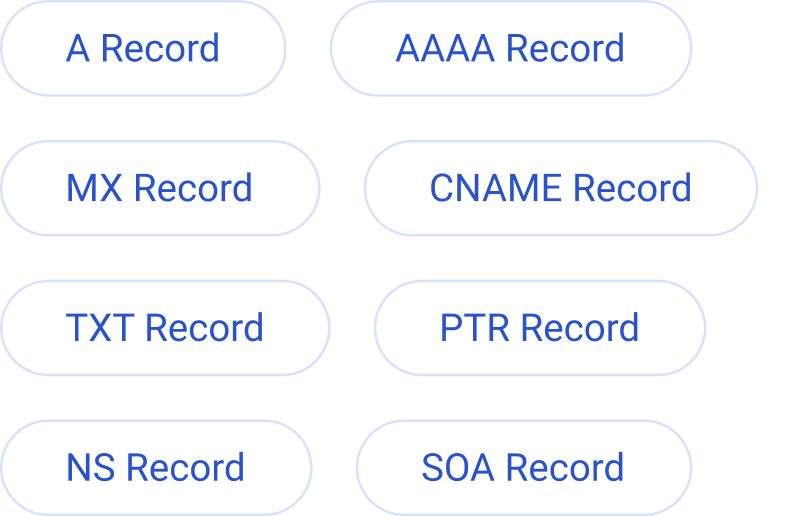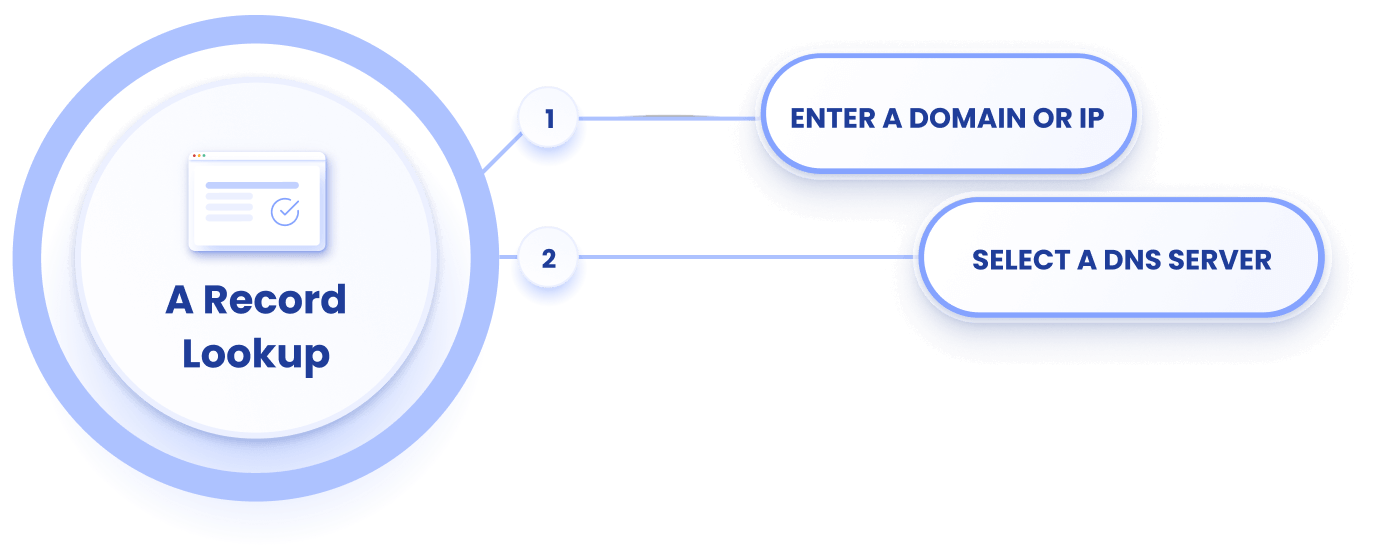A Records Lookup
Find A records on your domain by entering your domain or IP address and your DNS server host.
Check A Records For Your Domain
DNS A records are the foundation of how the internet connects users to your website. They link IP addresses to domain names, so when you enter a URL, your browser knows which IP address to connect you to. A records make websites accessible and support services like web hosting, email, verification, and APIs. They are a critical DNS record, and without them, your domain is essentially offline.
Regularly checking A records has several benefits. You can confirm your domain resolves to the proper IP, ensuring your website loads correctly. You can detect unauthorized or accidental changes to your DNS settings and use A records to rule out DNS as a cause of downtime or redirection errors. Knowing where to find your A records is an important step when updating or reconfiguring your DNS after changes or migrations.
EasyDMARC’s A Record Lookup tool is the easiest way to find your A records and analyze them for details.

Other Supported DNS Record Lookups
Our DNS record checker is comprehensive and capable of finding any and all records related to your domain’s DNS. Here’s what each of these record types does.
- A Record – Address records connect a domain name to an IPv4 address.
- AAAA Record – Quad A records connect a domain name to an IPv6 address.
- MX Record – Mail exchange records tell email servers where to deliver emails to your domain.
- CNAME Record – Canonical name records map one domain to another domain name rather than an IP address.
- TXT Record – Text records store text-based information used for email verification, security, and domain ownership validation.
- PTR Record – Pointer records are used for reverse DNS lookups. PTR lookups are usually used for logs, diagnostics, and verification.
- NS Record – A name server record specifies which name servers are authoritative for a domain.
- SOA Record – Start of Authority records contain administrative information about a domain’s DNS zone.
With EasyDMARC’s suite of free DNS record lookup tools, configuring, verifying, and managing your DNS is a breeze.

How EasyDMARC’s A Record Lookup Tool Works
With EasyDMARC’s A Record Lookup tool, you can quickly and easily find and analyse your A records by following these three steps.
- Enter your Domain url or IP address
- Select your DNS Server. This includes well-known servers like Google, Cloudflare, or Quad9. You can also enter your domain’s authoritative name server or SOA.
Get your Records or analyze them from a well-organized, easy-to-read list. Click on them for deeper analysis.

What is an A record lookup?
An A record lookup is a process that checks which IPv4 address a domain name points to by querying the domain’s DNS A record. In essence, it answers the question “What is the IP address of this domain?”
What are A and AAAA records?
While A records map domains to IPv4 addresses, like 93.184.216.34, AAAA records map domains to IPv6 addresses, like 2001:0db8:85a3::8a2e:0370:7334.
The main difference between IPv4 and IPv6 is that IPv4 addresses are nearly exhausted due to the huge number of internet-connected devices. IPv6 was developed to help handle this storage problem. IPv6 also supports auto-configuration, better routing efficiency, the IPSec security standard, and better performance and features.
The main reasons to use IPv4 are near-universal compatibility, easier implementation, and affordability.
What is the A record format?
The standard A record format in DNS is:
[Host] [TTL] [Class] [Type] [IPv4 Address]. The host is the domain or subdomain. The TTL (time to live) tells your domain how long to cache in seconds. The Class or DNS class is nearly always “IN” for internet. The Type (Record Type) will usually be A for IPv4, and the Address is the IPv4 Address to point to, such as 93.184.216.34.
Can I delete my A records?
You can delete your A records, but it will make your website unreachable through standard browsers. Email services may fail, and both traffic and SEO will experience downtime. The only reason to delete your A records is if you’re switching to another hosting provider, replacing your A record, or if the record is old, unused, or pointing to a decommissioned server.
How to do an A record check?
The easiest way to perform an A record check is to use a free A record checker tool, like the one from EasyDMARC. Alternatively, you can use the command line (nslookup example.com) in Command Prompt or (dig example.com A) in Terminal. If you’re using a domain registrar like Cloudflare or GoDaddy, they will often let you view your A records through the dashboard.

